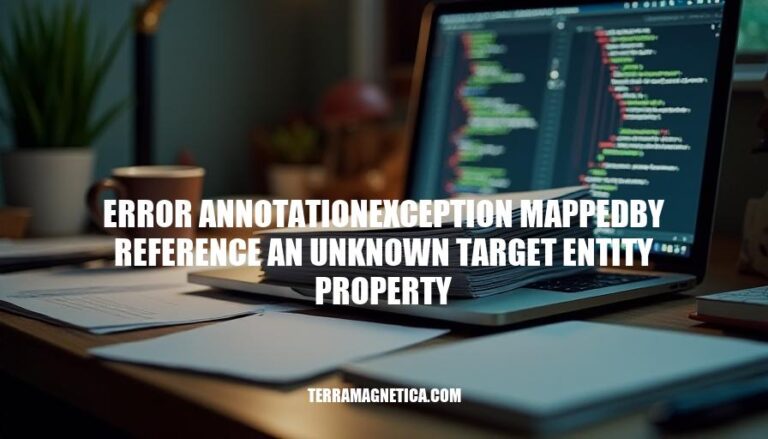


The error AnnotationException: mappedBy reference an unknown target entity property occurs in Java Persistence API (JPA) and Hibernate when the mappedBy attribute in a relationship annotation references a non-existent property in the target entity. This error is significant because it highlights issues in defining bidirectional relationships, which are crucial for maintaining data integrity and efficient database operations in JPA and Hibernate applications.
The error AnnotationException: mappedBy reference an unknown target entity property occurs in JPA and Hibernate when the mappedBy attribute in a relationship annotation refers to a non-existent property in the target entity.
Incorrect Property Name:
mappedBy attribute must match the exact name of the property in the target entity. For example, if the target entity has a property named users, using mappedBy = "user" will trigger this error.Missing Property in Target Entity:
mappedBy, the error will occur. Ensure the target entity includes the property being referenced.Inheritance Issues:
mappedBy attribute correctly references the property in the appropriate class.Access Type Mismatch:
@Access annotations if needed.The error AnnotationException: mappedBy reference an unknown target entity property typically occurs in JPA/Hibernate when the mappedBy attribute in a relationship annotation refers to a non-existent or incorrectly named property in the target entity. Here are the primary causes and examples of incorrect mappings:
Incorrect Property Name in mappedBy:
mappedBy attribute does not match any property name in the target entity.@Entity
public class User {
@ManyToMany(mappedBy = "user")
private Set<Account> accounts;
}
@Entity
public class Account {
@ManyToMany
@JoinTable(name = "account_user",
joinColumns = @JoinColumn(name = "account_id"),
inverseJoinColumns = @JoinColumn(name = "user_id"))
private Set<User> users;
}
mappedBy in User should be users, not user.Missing Property in Target Entity:
mappedBy.@Entity
public class Order {
@OneToMany(mappedBy = "order")
private List<Item> items;
}
@Entity
public class Item {
@ManyToOne
@JoinColumn(name = "order_id")
private Order order;
}
Item does not have a property named order, this error will occur.Incorrect Mapping in Bidirectional Relationships:
mappedBy attribute is used incorrectly in bidirectional relationships.@Entity
public class Department {
@OneToMany(mappedBy = "department")
private List<Employee> employees;
}
@Entity
public class Employee {
@ManyToOne
@JoinColumn(name = "department_id")
private Department dept;
}
mappedBy in Department should refer to dept in Employee, not department.Ensuring that the mappedBy attribute correctly references the property name in the target entity will resolve this error.
Here’s a step-by-step guide to troubleshoot the AnnotationException: mappedBy reference an unknown target entity property error:
Ensure you have correctly identified the entities and their relationships. For example, if you have User and Account entities with a many-to-many relationship:
@Entity
public class User {
@Id
@GeneratedValue(strategy = GenerationType.IDENTITY)
private Long id;
@ManyToMany(mappedBy = "users")
private Set<Account> accounts = new HashSet<>();
// getters and setters
}
@Entity
public class Account {
@Id
@GeneratedValue(strategy = GenerationType.IDENTITY)
private Long id;
@ManyToMany
@JoinTable(
name = "account_user",
joinColumns = @JoinColumn(name = "account_id"),
inverseJoinColumns = @JoinColumn(name = "user_id")
)
private Set<User> users = new HashSet<>();
// getters and setters
}
mappedBy AttributeEnsure the mappedBy attribute in the @ManyToMany annotation refers to the correct property name in the target entity. In the example above, mappedBy = "users" in the User entity should match the property name users in the Account entity.
Ensure there are no typos and that the property names are case-sensitive. For instance, mappedBy = "users" should exactly match the property name users in the Account entity.
Make sure both sides of the relationship are properly defined. For example, if you have a User entity with a Set<Account> accounts, the Account entity should have a corresponding Set<User> users.
Ensure the join table configuration is correct. The @JoinTable annotation should correctly specify the join columns and inverse join columns.
Sometimes, cleaning and rebuilding the project can resolve issues related to annotations and mappings. Use your IDE’s clean and build functions or run the following commands if using Maven:
mvn clean install
Carefully review the error message to identify the specific property causing the issue. The error message usually indicates which property in which entity is not correctly referenced.
By following these steps, you should be able to troubleshoot and resolve the AnnotationException: mappedBy reference an unknown target entity property error.
To avoid the AnnotationException: mappedBy reference an unknown target entity property error, follow these best practices:
mappedBy attribute refers to the correct property name in the target entity. For example, if the target entity has a property named users, use mappedBy = "users".@OneToMany, the other should use @ManyToOne.targetEntity in the annotation to avoid ambiguity.mappedBy matches exactly with the target entity’s property.@Entity or @Table annotations can cause issues.mappedBy attribute correctly references properties in inherited classes.By following these practices, you can avoid common errors and ensure your entity mappings are correctly configured.
Follow these steps:
mappedBy attribute in the @ManyToMany annotation refers to the correct property name in the target entity.Follow these best practices:
By following these steps and practices, you can ensure your entity mappings are correctly configured and avoid the AnnotationException: mappedBy reference an unknown target entity property error.